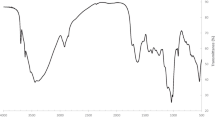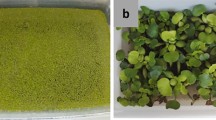Abstract
Aside from the ability of plants to remove domestic-industrial wastewater contaminants from various types of water, macrophytes can also serve as an alternative source of energy. The goal of the present study was to test the viability of biogas production using aquatic macrophyte species—Eichhornia crassipes and Pistia stratiotes—contaminated with cadmium (Cd) after the phytoremediation process. The plants were transferred to a nutrient solution contaminated with 0.8 mg L−1of Cd. The experiment was set up in a 2 × 3 factorial scheme with the presence or absence of Cd and three phytoremediation times (20, 40, or 60 days) using P. stratiotes followed by an additional treatment consisting of P. stratiotes + E. crassipes for 20 days. The acute and chronic effects of bioassays with the microcrustacean Daphnia similis were used to evaluate the ability of the macrophytes to remove toxicity by phytoremediation. The viability test of biogas production after phytoremediation was evaluated using micro-biodigesters. According to the results, at least 60 days of phytoremediation are necessary to remove/remediate the Cd present in the contaminated solution. The metal did not influence the macrophytes’ methanogenic activity, showing that these macrophytes can be used for biogas/methane production. The combination of Pistia stratiotes with Eichhornia crassipes is a good alternative to reduce phytoremediation time, but for 20 days of testing, the presence of Eichhornia crassipes reduces the biogas production/CH4. However, it is believed that if the digestion time is extended, this effect can be minimized. The phytoremediation time indicated that Pistia stratiotes must remain at least 60 days to remove/remediate the Cd present in the contaminated solution.









Similar content being viewed by others
References
Al Imam FI, Khan Z, Sarkar MM, Ali S (2013) Development of Biogas Processing from Cow dung, Poultry waste, and Water Hyacinth. Int J Nat Appl Science 2:13–17
Ali H, Khan E, Sajad MA (2013) Phytoremediation of heavy metals—Concepts and applications. Chemosphere 91:869–881
Andrade JCM, Tavares SRL, Mahler CF (2007) Fitorremediação: o uso de plantas na melhoria da qualidade ambiental. Ed. Oficina de textos, São Paulo 176 p
APHA AWWA (1998) WPCF Standard Methods for examination of water and wastewater, 20th edn. American Public Health Association, Washington, DC
Aurangzeb N, Nisa S, Bibi Y, Javed F, Hussain F (2014) Phytoremediation potential of aquatic herbs from steel foundry effluent. Braz J Chem Eng 31:881–886. https://doi.org/10.1590/0104-6632.20140314s00002734
Barros Regina Mambeli (2012) Tratado Sobre Resíduos Sólidos: gestão, uso e sustentabilidade. Rio de Janeiro: Interciência; Minas Gerais: Acta
Barua VBA, Kalamdhad S (2016) Water hyacinth to biogas: a review. Pollut Res 35(3):491–501
Bharti S, Banerjee TK (2013) Bioassay analysis of efficacy of phytoremediation in decontamination of coal mine effluent. Ecotoxicol Environ Saf 92:312–319
Chen Y, Cheng JJ, Creamer KS (2008) Inhibition of anaerobic digestion process: A review. Bioresource Technol 99(10):4044–4064
El-Shinnawi MM, Alaa El-Din MN, El-Shimi SA, Badawi MA (1989) Biogas production from crop residues and aquatic weeds. Resour Conserv Recycl 3(1):33–45
Fawzy MA et al (2012) Heavy metal biomonitoring and phytoremediation potentialities of aquatic macrophytes in River Nile. Environ Monit Assess 184(3):1753–1771
Hidaka T, Arai S, Okamoto S, Uchida T (2013) Anaerobic co-digestion of sewage sludge with shredded grass from public green spaces. Bioresource Technol 130:667–672. https://doi.org/10.1016/j.biortech.2012.12.068.
Hoagland DR, Arnon DI (1950) The water-culture method for growing plants without soil. Agricultural Experimental Station 32 p
Iannicelli L A. Reaproveitamento Energético do biogás de uma indústria cervejeira. 2008, 83f. Dissertação de mestrado em Engenharia Mecânica. Universidade de Taubaté. Taubaté, São Paulo, 2008.
Koyama M, Yamamoto S, Ishikawa K, Ban S, Toda T (2017) Inhibition of anaerobic digestion by dissolved lignin derived from alkaline pre-treatment of an aquatic macrophyte. Chem Eng J 311:55–62
LABIOGAS (2013) Laboratório de Biogás do Parque Tecnológico de Itaipu - PTI. Disponível em: http://www.hidroinformatica.org/index.php/br/conheca-o-cih/parceiros/plataforma-itaipu-de-energiasrenovaveis/labiogas. Accessed em: 20 jun. 2017.
Martelo J, Lara-Borrero JA (2012) Floating macrophytes on the wastewater treatment: a state of the art review. Ing Cienc 8(15):221–243
Martínez FS, Franceschini MC, Poi A (2013) Preferencia alimentaria de Neochetina eichhorniae (Coleoptera: Curculionidae) en plantas acuáticas de diferente valor nutritivo. Rev Col Entomol 39(1):81–87
Mishra S, Maiti A (2017) The efficiency of Eichhornia crassipes in the removal of organic and inorganic pollutants from wastewater: a review. Environ Sci Pollut Res 24:7921–7937. https://doi.org/10.1007/s11356-016-8357-7
O’Sullivan C, Rounsefell B, Grinham A, Clarke W, Udy J (2010) Anaerobic digestion of harvested aquatic weeds: water hyacinth (Eichhornia crassipes), cabomba (Cabomba caroliniana) and salvinia (Salvinia molesta). Ecol Eng 36:1459–1468. https://doi.org/10.1016/j.ecoleng.2010.06.027
Pantawong R, Chuanchai A, Thipbunrat P, Unpaprom Y, Ramaraj R (2015) Experimental Investigation of Biogas Production from Water Lettuce, Pistia stratiotes L. Emerg Life Sci Res 1:41–46
Pereira BFF et al (2011) Cadmium availability and accumulation by lettuce and rice. Rev Bras Ciênc Solo 35(2):645–654
Pereira FJ et al (2014) Lead tolerance of water hyacinth (Eichhornia crassipes Mart. – (Pontederiaceae) as defined by anatomical and physiological traits. An Acad Bras Ciênc 86(3):1423–1433
Qiong P, Wei C, Lamei W, Lianyang B (2017) The uptake, accumulation, and toxic effects of cadmium in barnyardgrass (Echinochloa crus-galli). Pol J Environ Stud 26:779–784. https://doi.org/10.15244/pjoes/65780
Razak ASBA, Wahid ZBA, Zakaria IB, Said MIBM, Sulaiman SB, Halim HBA (2013) Treatment of industrial wastewater at Gebeng area using Eichhornia crassipes sp. (water hyacinth), Pistia stratiotes sp. (water lettuce) and Salvinia molesta sp. (giant salvinia). Adv Environ Biol 7:3802–3807
Rezania et al (2015) The diverse applications of water hyacinth with main focus on sustainable energy and production for new era: an overview. Renew Sust Energ Rev 41:943–954
Ribeiro EM, Barros RM, Santos IFS, Sampaio LC, Santos TV, Silva FGB, Silva APM, Freitas JVR (2016) Power generation potential in posture aviaries in Brazil in the context of a circular economy. Sustainable Energy Technologies and Assessments 18:153–163
Salomon KR, Lora EES (2009) Estimate of the electric energy generating potential for different sources of biogas in Brazil. Biomass Bioenergy 33:1101–1107
Santamaría L (2002) Why are most aquatic plants widely distributed? Dispersal, clonal growth and small-scale heterogeneity in a stressful environment. Acta Oecologica 23(3):137–154
Sharma S, Singh B, Manchanda VK (2014) Phytoremediation: role of terrestrial plants and aquatic macrophytes in the remediation of radionuclides and heavy metal contaminated soil and water. Environ Sci Pollut Res 22(2):946–962. https://doi.org/10.1007/s11356-014-3635-8
Silva SA et al (2013) Reproductive, cellular, and anatomical alterations in pistia stratiotes L. plants exposed to cadmium. Water Air Soil Pollut 224:1465
Sinha S, Mukherjee SK (2009) Pseudomonas Aeruginosa kucd1, a possible candidate for cadmium bioremediation. Braz J Microbiol 40:655–662
Souza SNM (2016) Manual de geração de energia elétrica a partir do biogás no meio rural. Dissertação. Universidade Estadual do Oeste do Paraná
Sultana R, Kobayashi K (2011) Potential of barnyard grass to remediate arsenic-contaminated soil. Weed Biol Manag 11(1):12–17
Thomaz SM, Bini LMA (1999) Expansão das macrófitas aquáticas e implicações para o manejo de reservatórios: um estudo na represa de Itaipu. In: Henry R (ed) Ecologia de reservatórios: estrutura, função e aspectos sociais. Fundibio, Botucatu, pp 599–625
United States Environmental Protection Agency (2007) Method 3051 A: microwave assisted acid digestion of sediments, sludges, soils and oils. USEPA, Washington
Van Houten BH, Roest K, Tzeneva VA, Dijkman H, Smidt H, Stams AJ (2006) Occurrence of methanogenesis during start-up of a full-scale synthesis gas-fed reactor treating sulfate and metal-rich wastewater. Water Res 40:553–560. https://doi.org/10.1016/j.watres.2005.12.004
Zhang H, Tian Y, Wang L, Zhang L, Dai L (2013) Ecophysiological characteristics and biogas production of cadmium-contaminated crops. Bioresour Technol 146:628–636. https://doi.org/10.1016/j.biortech.2013.07.148
Acknowledgments
We would like to thank the following people:
• IX Engenharia Santos for providing the GEM5000® apparatus.
• Frigorífico Frivasa for supplying the inoculums.
• CAPES (Coordenação de Aperfeiçoamento de Pessoal de Nível Superior) for providing the following scholarship: PNPD post-doctoral program in environment and water resources (MEMARH).
Author information
Authors and Affiliations
Corresponding author
Additional information
Responsible editor: Philippe Garrigues
Rights and permissions
About this article
Cite this article
Fernandes, K.D., Cañote, S.J.B., Ribeiro, E.M. et al. Can we use Cd-contaminated macrophytes for biogas production?. Environ Sci Pollut Res 26, 27620–27630 (2019). https://doi.org/10.1007/s11356-018-2318-2
Received:
Accepted:
Published:
Issue Date:
DOI: https://doi.org/10.1007/s11356-018-2318-2




